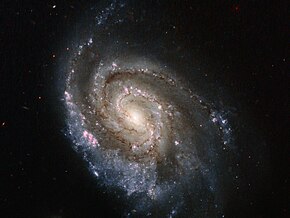NGC 6984
| NGC 6984 | |
|---|---|
 NGC 6984 taken by the Hubble Space Telescope | |
| Observation data (J2000 epoch) | |
| Constellation | Indus |
| Right ascension | 20h 57m 53.987s[1] |
| Declination | −51° 52′ 15.13″[1] |
| Redshift | 0.015386[1] |
| Heliocentric radial velocity | 4577 km/s[1] |
| Distance | 180 million ly[2] |
| Apparent magnitude (V) | 12.65[1] |
| Apparent magnitude (B) | 13.19[1] |
| Characteristics | |
| Apparent size (V) | 1.403 x 1.038 arcmin[1] |
| Other designations | |
| ESO-LV 235-0200, 2MASX J20575398-5152151, [CHM2007] LDC 1431 J205753.98-5152151, AM 2054-520, IRAS 20543-5203, PSCz Q20543-5203 [SLK2004] 1671, APMBGC 235+046+104, IRAS F20543-5203, QDOT B2054196-520349, 6dFGS gJ205754.0-515215, ISOSS J20578-5152, SGC 205419-5203.8, ESO 235-20, LEDA 65798, [CHM2007] HDC 1131 J205753.98-5152151 | |
NGC 6984 is a barred spiral galaxy located 180 million light years away in the constellation Indus.
It is known for having been the host of two recent supernovae: one in 2012 first known as SNhunt142[3] (later designated SN 2012im[4]), and one in 2013 known as SN 2013ek. The first was a Type Ic[5] and the second was a Type Ib/c.[6] HST observations were initiated by Dr. Dan Milisavljevic.[7] NASA's press release about SN 2013ek said:
"It is so close to where SN 2012im was spotted that the two events are thought to be linked; the chance of two completely independent supernovae so close together and of the same class exploding within one year of one another is a very unlikely event. It was initially suggested that SN 2013ek may in fact be SN 2012im flaring up again, but further observations support the idea that they are separate supernovae — although they may be closely related in some as-yet-unknown way."[8]
Gallery
-
 The galaxy NGC 6984, an elegant spiral galaxy in the constellation Indus roughly 200 million light-years away from Earth.
The galaxy NGC 6984, an elegant spiral galaxy in the constellation Indus roughly 200 million light-years away from Earth.
References
- ^ a b c d e f g "Search Results for NGC 6984". Astronomical Database. SIMBAD. Retrieved 5 November 2013.
- ^ "Stellar explosions in NGC 6984". ESA/Hubble Picture of the Week. Retrieved 5 November 2013.
- ^ "ATel #4300: PESSTO spectroscopic classification of optical transients".
- ^ http://www.cbat.eps.harvard.edu/iau/cbet/003600/CBET003607.txt [bare URL plain text file]
- ^ "ATel #5225: A new SN suspect at the position of SNhunt142 discovered 1 year ago".
- ^ "ATel #5227: Spectroscopic classification for PSN J20575390-5152245 with FLOYDS at Faulkes Telescope South".
- ^ "13505 Program Information".
- ^ Hubble Catches Stellar Explosions in NGC 6984, NASA, 13 November 2013, archived from the original on 21 November 2013
External links
 Media related to NGC 6984 at Wikimedia Commons
Media related to NGC 6984 at Wikimedia Commons
- v
- t
- e
- NGC 6979
- NGC 6980
- NGC 6981
- NGC 6982
- NGC 6983
- NGC 6984
- NGC 6985
- NGC 6986
- NGC 6987
- NGC 6988
- NGC 6989
 | This spiral galaxy article is a stub. You can help Wikipedia by expanding it. |
- v
- t
- e














